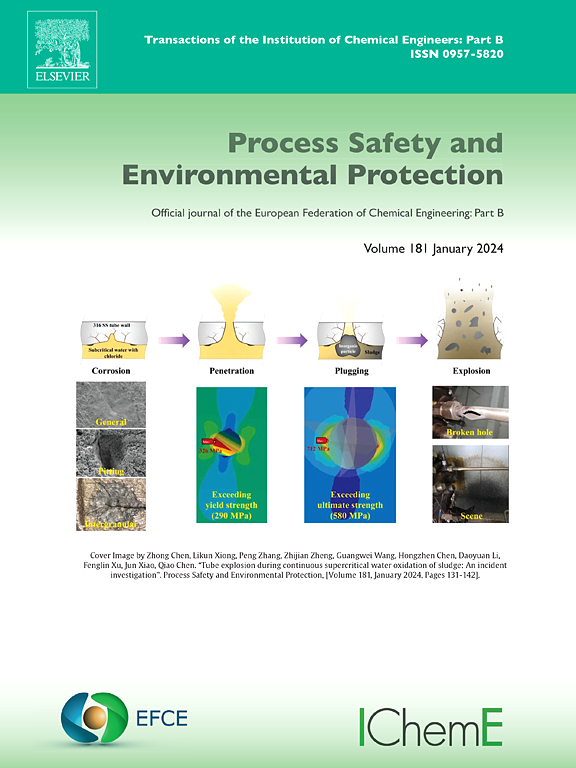低品位氧化锰铁矿石与废铜协同利用方法:选择性萃取Mn合成MnFe2O4
IF 7.8
2区 环境科学与生态学
Q1 ENGINEERING, CHEMICAL
引用次数: 0
摘要
随着高品位锰矿逐渐枯竭,开发利用复杂难熔氧化锰矿已成为保障未来锰资源安全的必然策略。此外,钛白粉生产行业的副产品废铜大量堆积在工厂附近,严重制约了钛白粉生产行业的可持续发展。本研究利用废铜矿的还原性,提出了低品位氧化锰矿与废铜矿共焙烧分离回收铁锰的工艺。通过调节焙烧条件,将Mn转化为水溶性MnSO4,将Fe转化为水不溶性Fe2O3,再通过水浸实现铁锰的有效分离。在最优条件下,Mn浸出率可达93.14% %,Fe溶出率仅为1.82% %。对浸出液进行水解沉淀去除Fe和Al,得到Mn浓度为17.22 g/L的浸出液。随后,通过水热法制备了MnFe2O4,饱和磁化强度为49.98 emu/g,矫顽力为36.30 Oe,剩余磁化强度为3.75 emu/g。浸出渣主要为赤铁矿和石英,铁品位达59.45 %,可作为配铁矿原料。该工艺既实现了低品位氧化锰矿铁锰资源的分离回收,又实现了废铜矿的资源化利用,可促进钛白粉生产行业的可持续发展。此外,整个过程显示出接近零排放的潜力,在经济和环境效益方面为工业规模的实施提供了竞争优势。本文章由计算机程序翻译,如有差异,请以英文原文为准。
A synergistic co-utilization method of low-grade ferromanganese oxide ore and waste copperas: Selective extraction of Mn and synthesis of MnFe2O4
With the gradual depletion of high-grade manganese ores, developing and utilizing complex refractory ferromanganese oxide ore has become an inevitable strategy to ensure future manganese resource security. In addition, a large amount of waste copperas, a by-product of the titanium dioxide production industry, is piled up near the factory, which seriously restricts the sustainable development of the titanium dioxide production industry. Leveraging the reducing properties of waste copperas, this study proposes a process for the separation and recovery of Fe and Mn through co-roasting low-grade ferromanganese oxide ore with waste copperas. Through regulating the roasting conditions, Mn can be converted into water-soluble MnSO4 and Fe into water-insoluble Fe2O3, and then the effective separation of Fe and Mn can be realized by water leaching. Under optimal conditions, Mn leaching efficiency reached 93.14 % with only 1.82 % Fe dissolution. The leaching solution was treated via hydrolytic precipitation to remove Fe and Al, yielding a solution with an Mn concentration of 17.22 g/L. Subsequently, MnFe2O4 was synthesized via the hydrothermal method, exhibiting a saturation magnetization of 49.98 emu/g, coercivity of 36.30 Oe, and remanent magnetization of 3.75 emu/g. The leaching residue mainly consists of hematite and quartz with Fe grade up to 59.45 %, which can be used as a raw material for iron ore blending. The process proposed not only realizes the separation and recovery of Fe and Mn resources in low-grade ferromanganese oxide ore but also realizes the resource utilization of waste copperas, which can also promote the sustainable development of the titanium dioxide production industry. Moreover, the entire process demonstrates near-zero emissions potential, offering competitive advantages for industrial-scale implementation in terms of both economic and environmental benefits.
求助全文
通过发布文献求助,成功后即可免费获取论文全文。
去求助
来源期刊

Process Safety and Environmental Protection
环境科学-工程:化工
CiteScore
11.40
自引率
15.40%
发文量
929
审稿时长
8.0 months
期刊介绍:
The Process Safety and Environmental Protection (PSEP) journal is a leading international publication that focuses on the publication of high-quality, original research papers in the field of engineering, specifically those related to the safety of industrial processes and environmental protection. The journal encourages submissions that present new developments in safety and environmental aspects, particularly those that show how research findings can be applied in process engineering design and practice.
PSEP is particularly interested in research that brings fresh perspectives to established engineering principles, identifies unsolved problems, or suggests directions for future research. The journal also values contributions that push the boundaries of traditional engineering and welcomes multidisciplinary papers.
PSEP's articles are abstracted and indexed by a range of databases and services, which helps to ensure that the journal's research is accessible and recognized in the academic and professional communities. These databases include ANTE, Chemical Abstracts, Chemical Hazards in Industry, Current Contents, Elsevier Engineering Information database, Pascal Francis, Web of Science, Scopus, Engineering Information Database EnCompass LIT (Elsevier), and INSPEC. This wide coverage facilitates the dissemination of the journal's content to a global audience interested in process safety and environmental engineering.
 求助内容:
求助内容: 应助结果提醒方式:
应助结果提醒方式:


